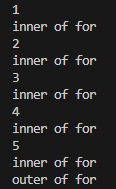一.变量、字符串、print、类型转换、运算符
message = "Hello Python world" #字符串变量
a,b,c = 9,9,3
print(message)
print("apple"+str(4))
print(1.4+int("1"))
print(a%4,b//4,c**2)
![0f0b46ef-d269-4a7c-8123-8b889528a7a6]()
二.语句
- while循环
condition = 1
while condition < 10:
print(condition)
condition = condition + 1
![cf2d26af-ea78-466c-8b3f-49f0aff5364b]()
- for循环
ex_list = [1,2,3,4,5]
for i in ex_list:
print(i)
print('inner of for')
![3f155dd0-5cf8-4732-8bbb-5e3c011eb5d3]()
for i in range(1,10):
print(i)
![95601696-cc87-4fe0-a699-3f9efba98c8b]()
- if、elif、else
x=5
y=5
z=9
if x<5>4:
print('x<5>4')
elif (x<5)<4:
print(f'(x<5)<4:{x<5}')
else:
print('else')
![7b5978e8-8328-4452-b62b-fed7cc2f0211]()
x<y<z被解释为(x<y) and (y<z)- f字符串:
print(f'(x<5)<4:{x<5}')
要在字符串中插入变量的值,可先在左引号前加f,再将变量放入花括号内










 浙公网安备 33010602011771号
浙公网安备 33010602011771号